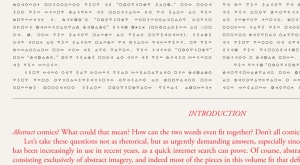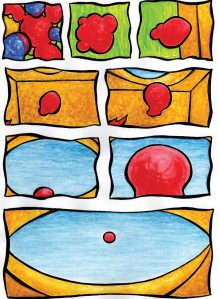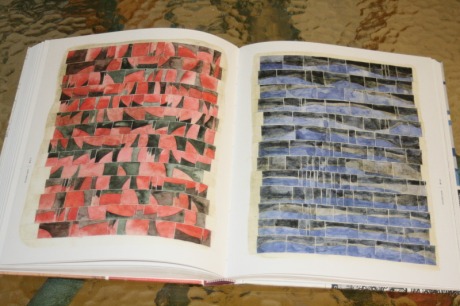 Abstract Comics: The Anthology is an impressive collection of old and new work with unique pages covering exactly what the title says. Fantagraphics’ bold book covers the years from 1967 to the present, with a selection of abstract comics from over 40 artists.
Abstract Comics: The Anthology is an impressive collection of old and new work with unique pages covering exactly what the title says. Fantagraphics’ bold book covers the years from 1967 to the present, with a selection of abstract comics from over 40 artists.
Now I think I’m a pretty open comics reader. Having primarily grown up on superheroes however, it’s only been the last 5 years that I’ve expanded my reading habits to include indie titles. It was Craig Thompson’s masterwork, Blankets that woke me up to the world beyond spandex and ever since then I’ve pretty much bought an indie title every week.
Abstract comics is a foreign concept to me though. I’m surprised that I’ve never thought of the genre before. It makes complete sense and after pouring through this hardcover from Fantagraphics I have a greater understanding and appreciation for the form. This intriguing 208 page tome includes some of the best work from pioneers in the field, as well as new work created for the anthology by artists including James Kochalka.
The introduction of the book is the only piece with words strung together that actually form an obviously coherent thought. Andrei Molotiu is the editor of Abstract Comics, and quite an authority on the subject. His work as an artist is reflected here and his introductory summary of what abstract comics actually are, as opposed to the use of the word in other art forms, is insightful. Even this obligatory introduction is treated with a loose abstract veneer, with plain text comprising the bottom half of each page, while above it sits the same words through the lens of simple shapes, which reminded me of the Kryptonese language. Yes, even with abstract comics, I can’t help but see things through my fanboy glasses. (There’s also a look at the history of abstract comics here). Molotiu defines the term thusly;
abstract comics can be defined as sequential art consisting exclusively of abstract imagery, and indeed most of the pieces in this volume fit that definition squarely. But the definition should be expanded somewhat, to include those comics that contain some representational elements, as long as those elements do not cohere into a narrative or even into a unified narrative space.
Whew. It’s the kind of talk that gets art students all sweaty. His 8 page introduction is littered with great work as he shows us the history of abstract comics, with examples of a bunch of artists unfamiliar to me to those who I didn’t expect to see, such as Wassily Kandinsky, Willem de Kooning, Winsor McCay and Steve Ditko.
 Things kick off with a great piece from 1967 by R. Crumb, as originally seen in Zap #1. As you’d expect, it’s only 3 pages, but packs a lot of zest, with rounded figures, cheeky expressions and wild imagery. For the next 200 plus pages I was bombarded (in a good way) with every form and technique imaginable. I never knew what each turn of the page would bring. Black and white, pencil sketches, colour paintings and more – it’s all accounted for. Most of the works are only 3 or 4 pages long, with little or no text and some semblance of structured panels. I found myself treating the book like a portable art gallery as I let the images wash over me and tried to grasp their meaning. With close looks, there are stories of sorts to be told here, but as Molotiu mentions in the intro, abstract comics don’t have a narrative. I couldn’t help myself though and on some occasions examined the shapes in an attempt to form one. However, like all art the point is the enjoyment of the work first and foremost, rather than a desperation to cram it through out structured reasoning.
Things kick off with a great piece from 1967 by R. Crumb, as originally seen in Zap #1. As you’d expect, it’s only 3 pages, but packs a lot of zest, with rounded figures, cheeky expressions and wild imagery. For the next 200 plus pages I was bombarded (in a good way) with every form and technique imaginable. I never knew what each turn of the page would bring. Black and white, pencil sketches, colour paintings and more – it’s all accounted for. Most of the works are only 3 or 4 pages long, with little or no text and some semblance of structured panels. I found myself treating the book like a portable art gallery as I let the images wash over me and tried to grasp their meaning. With close looks, there are stories of sorts to be told here, but as Molotiu mentions in the intro, abstract comics don’t have a narrative. I couldn’t help myself though and on some occasions examined the shapes in an attempt to form one. However, like all art the point is the enjoyment of the work first and foremost, rather than a desperation to cram it through out structured reasoning.
 Molotiu’s work, The Cave was definitely a “wow” moment for me with its bold colours and gem like qualities, as was Andres Pearson’s work, with its swirling organic structures. Through some pages I could see how the panels, or the shapes within those panels, related to each other, which gave clarity to Molotiu’s introductory definition as to why this is different from abstract work done in other fields, such as cinema. James Kochalka’s (American Elf) work is exuberant and playful, as is Mike Getsiv’s. Blaise Larmee’s I Would Like To Live There is simple yet elegant while Life, Interwoven by Alexey Sokolin is 6 pages of increasing fury.
Molotiu’s work, The Cave was definitely a “wow” moment for me with its bold colours and gem like qualities, as was Andres Pearson’s work, with its swirling organic structures. Through some pages I could see how the panels, or the shapes within those panels, related to each other, which gave clarity to Molotiu’s introductory definition as to why this is different from abstract work done in other fields, such as cinema. James Kochalka’s (American Elf) work is exuberant and playful, as is Mike Getsiv’s. Blaise Larmee’s I Would Like To Live There is simple yet elegant while Life, Interwoven by Alexey Sokolin is 6 pages of increasing fury.
It’s hard to describe the experience of reading this anthology, but it must have been that much harder to choose the artists whose work would be shown here, especially considering this is the first book of its kind and it covers 4 decades. Book designer Jacob Covey must also be mentioned as there’s an undeniable sense of purpose that holds these pages together, from the cover to artists’ credits to last few pages. It’s subtle which allows the abstract comics to own the spotlight.
The book concludes with handy artist biographies for those that would like to discover more about them, and there’s also a useful accompanying blog which features work from the anthology and elsewhere.
I’ll admit that it was sheer curiosity that made me read this, and after enjoying its diverse offerings it brought me back to my art school days when I was exposed to a wide array of artists. It’s obviously a difficult book to review as well, especially as there’s no Good Guy A punches Bad Guy B action, but it was a treat for my often superhero consuming eyes. This is a book for readers who like fine art or those who would like to expand their sequential art experiences. A hearty slap on the back for Fantagraphics for choosing to create this marvelous example of a widely unknown artistic expression.



5 Comments
Comments RSS TrackBack Identifier URI

Abstract Comics The Blog: Our First Review
Thanks, Kris!
I saw an early copy of this book and it is totally gorgeous! Nice thoughtful review.
Cheers Chris. It is a good looking book!
Kris
Thanks Kris for the review and for obviously having taken time to really delve into the work. As an artist in the book, I am thrilled to be part of Andrei’s wonderful tome.
[…] can read one of the first reviews at […]